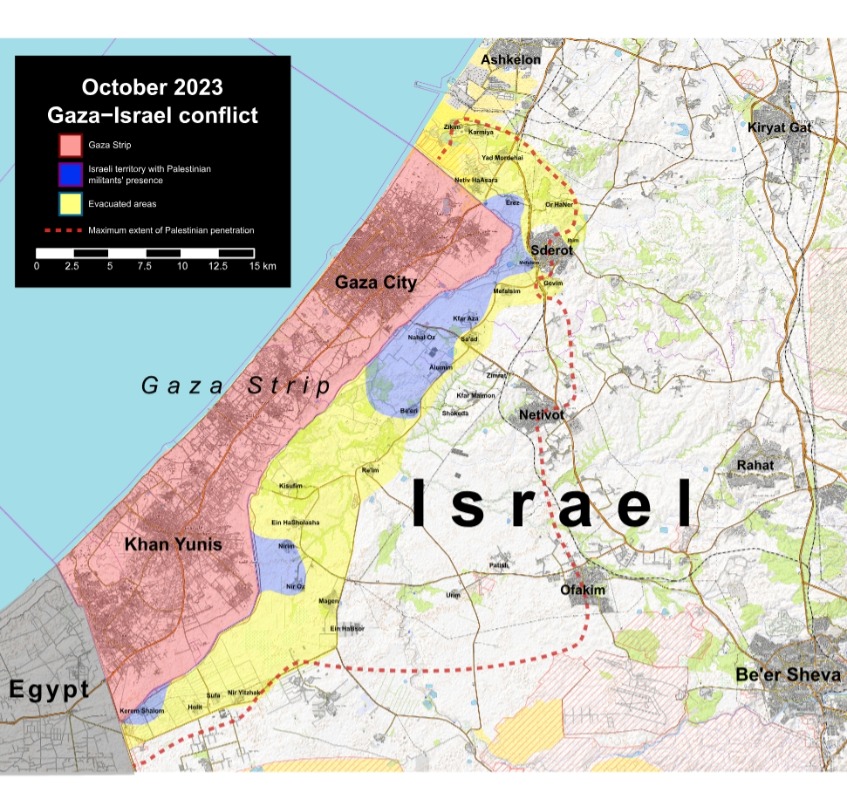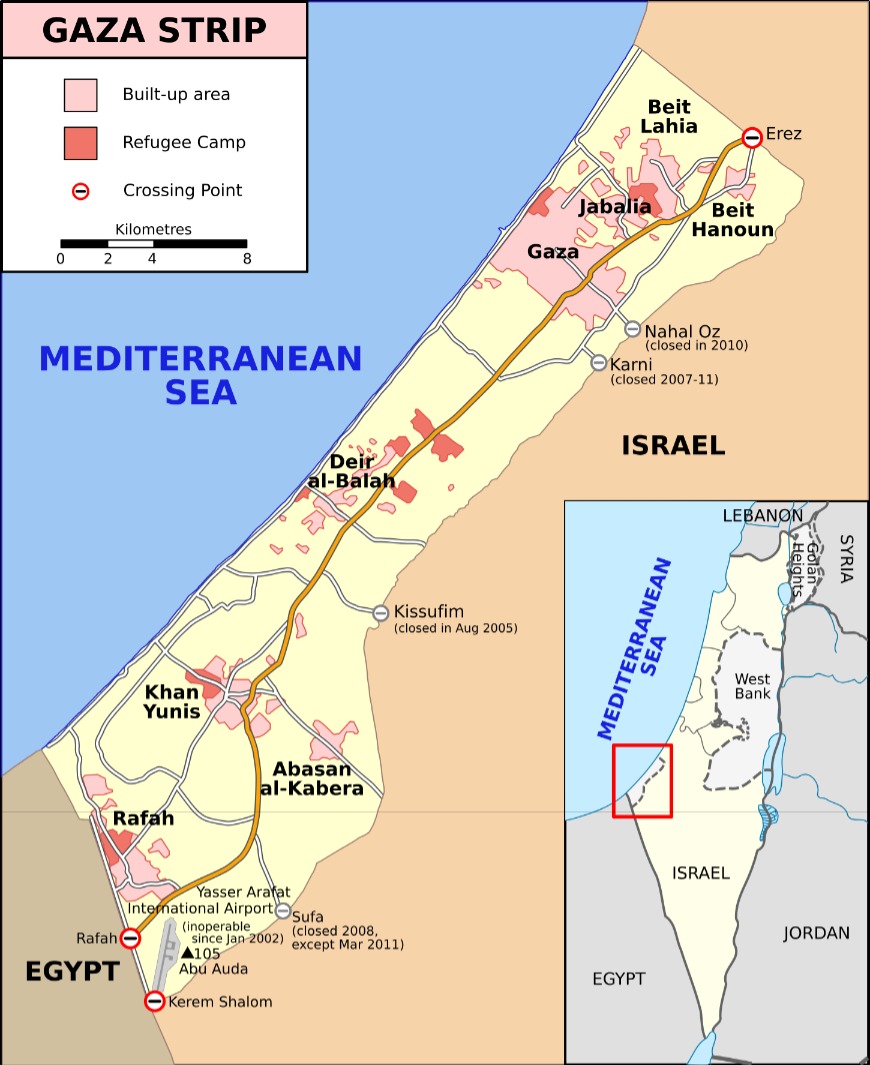Below is a new blog post from our friend William (Chip) Sayers. As it about the current fighting between Hamas and Israel, I am almost afraid to post it, as anything you say is going to offend someone somewhere. But… we push forward, in the spirit of open discussion, putting the usual disclaimer that this is Chip Sayers’ personal evaluation and does not represent the position of The Dupuy Institute, and so on and so forth.
His posting:
Of Rockets and Hospitals
Recently, a Gaza City hospital was reportedly destroyed with great loss of life. At first, the Israeli Air Force was blamed — with all the footage of buildings collapsing after IAF strikes, it seemed the logical explanation. However, a second narrative sprang up when an audio file of what was purported to a Hamas guerilla reporting to his leadership that the strike was actually by a malfunctioning Hamas rocket inadvertently falling on the hospital. If one blindly believes one side or the other, this is a simple problem: the bad guys did it and are trying to shift the blame to the good guys. For the rest of us with more critical minds, we want to know if this is something that can be teased apart to reveal the truth.
First off, we need to explore motive: why would either side deliberately do this? The Hamas audio file clearly portrays the incident as an accident, so motive is not a factor on their side — they didn’t mean to do it.
Israel’s position in more complex. Two weeks into this war, Tel Aviv has more worldwide support than they have enjoyed in decades, primarily it seems, due to the savage nature of Hamas’ surprise attack and a clear attempt to intimidate Israel through deliberately repulsive inhumane actions. This support may not last long and any misstep by Tel Aviv could cause it to vanish altogether. Certainly, the deliberate bombing of a Palestinian hospital would qualify as a massive misstep. Therefore, it seems highly unlikely that Israel would risk so much for so little advantage. Indeed, what advantage could be derived from such a strike? Even if Netanyahu was hell-bent on genocide, this would be a bad move at this stage of the war.
If Israel did this, it is far more likely that it was a mistake — similar to the U.S. bombing of the Chinese Embassy in Belgrade twenty-four years ago. In that particular case, we had paid little attention to Yugoslavia for the previous decade and our files were in pitiful shape [Chip would probably know this due to his background]. Meanwhile, the Chinese Embassy had moved without our notice. I’m sure the Dept. of State knew exactly where it was, but Dept. of Defense, not so much. Could this have been the result of a similar mistake? Possibly, but Gaza isn’t a backwater that Israeli intelligence has ignored for the previous decade. Further, hospitals — particularly in wartime — have distinct signatures: lots of traffic, including multiple ambulances at any given time, 24-hour service, plus they are usually distinctively marked. So, it seems unlikely that it could have been a case of misidentification.
If this was not an intentional act, could it have been some kind of mistake? The strategic bombing campaign against Germany in WWII is replete with examples of bombers — even lead bombers — being hit at the moment of bomb release which cause the deadly payloads to go astray. In December, 1972, a USAF B-52 infamously damaged the Bac Mai hospital in Hanoi in a similar occurrence. Further, the bombs themselves can be damaged such that fins are bent or fail to deploy, causing the missile to go astray. Even GPS-guided bombs can malfunction or fall to human error with unintended consequences. On 5 December 2001, Hamid Karzai, future President of Afghanistan was almost killed when an attack controller changed the batteries on his GPS kit just before a strike and inadvertently ordered the bomb onto his own coordinates. Could this have been a malfunction or mistake on the part of the IAF? Yes, absolutely.
Could this have been caused by a Hamas rocket? Yes. In fact, it’s inevitable. While some of Hamas’ rockets are factory-made in Iran, it appears that the vast majority are “homemade” in small sheet-metal shops on-site. While the designs have been largely standardized, the potential for malfunctions is fairly high. When tens of thousands of rockets are launched, a certain percentage of them are inevitably going to go astray. In point of fact, Hamas and Hezbollah actually depend on the fact that these things land indiscriminately among the general population of Israel. While a portion of Hezbollah’s rockets are guided to one degree or another, the vast majority of both group’s are not, so many of the attacking rockets may be malfunctioning without anyone being the wiser. It’s actually surprising that more “short rounds” of Hamas rockets haven’t been reported falling on Gaza.
So, what can the actual damage to the hospital tell us? Well, for one thing, it tells us someone is lying. It is almost inconceivable that 500 people died in that strike given the damage reported. Had the hospital collapsed entirely, that would be a high figure. But there is no significant structural damage to the building to be seen and a very small crater in the pavement (2-3 feet deep by about as wide), consistent with the detonation of a relatively small rocket warhead detonation. A dozen, two dozen, maybe a handful more deaths could have resulted, but 500 is patently ludicrous. In a perfect storm of circumstances, a 2,000lb bomb might have done that kind of damage, but it would have had to be an airburst detonation roughly 30-50 feet above the ground. That would almost certainly have been a preplanned act with deliberate fuzeing to kill the maximum number of people. We have seen no evidence whatsoever that the IAF has made other attacks in a similar fashion. A malfunction or mistake with a 2,000lb bomb would have involved a bomb fuzed to detonate after penetrating deep into the ground — which matches what we have seen thus far as they have brought down building after building with such attacks. Had one of these attacks gone astray for whatever reason, there would be a crater in evidence — on the order of 30 or 40 feet wide by 20 feet or more deep, nothing like what we’ve seen.
The evidence is leaning towards a Hamas rocket, but an IAF bomb cannot be ruled out. The question remains, who benefits? Clearly, it’s Hamas. U.S. support has weakened already, with Congressmen and college students protesting Israeli “war crimes.” The narrative that Israel did this serves to give the sides a moral equivalence in some minds. On the other hand, Israel has everything to lose and nothing to gain by such butchery.
And this, my friends, is a good example of intelligence analysis. You take disparate fragments of information, paste them into a framework that tells a plausible story, and you make a judgement call. Hopefully, the analyst has his or her judgment backed by plenty of relevant experience. There are no crystal balls and only on the rarest occasions does the enemy reveal his evil plans within earshot of some collector. And even then, you always have to be suspicious that he’s feeding you the information for his own nefarious reasons.
My own call? Hamas did it. They may have even done it deliberately — we saw that happen often enough 25 years ago in the Balkans. However, we won’t get that paranoid. The likeliest explanation is a malfunction, and I’m sticking with my story.




